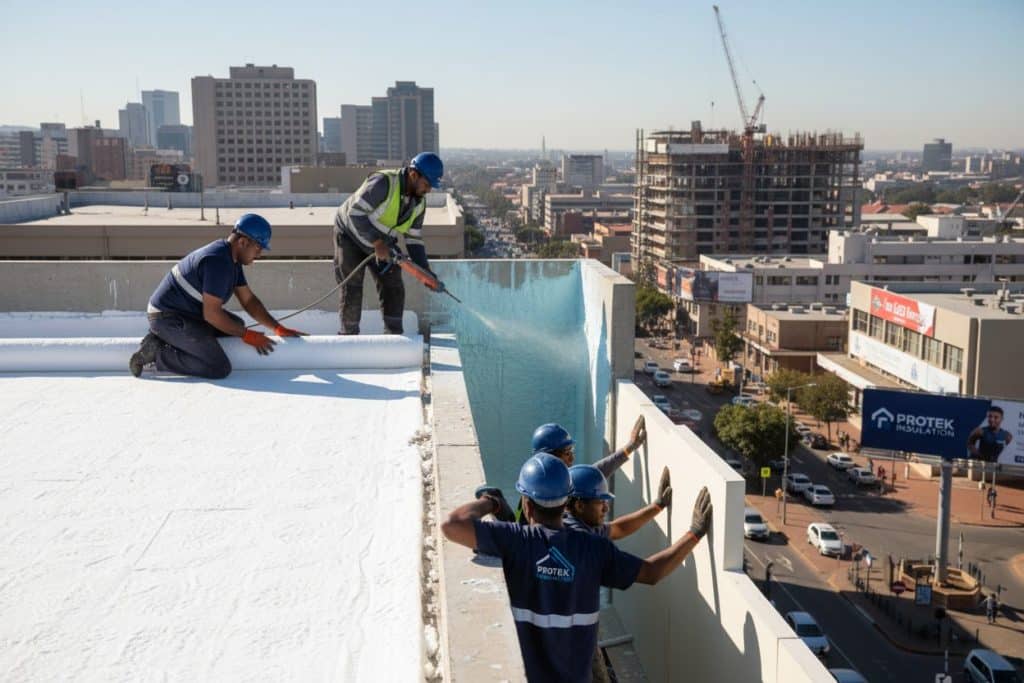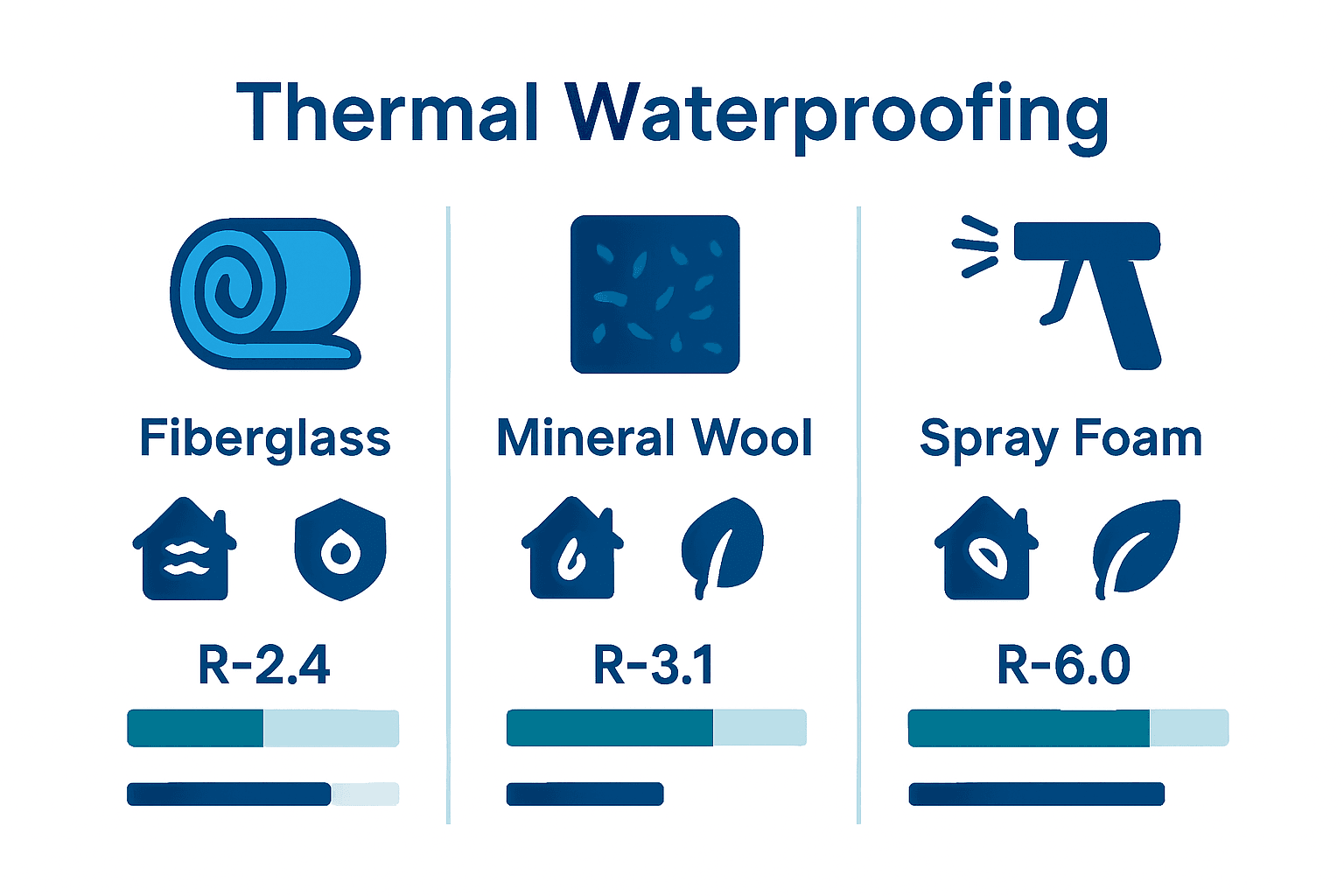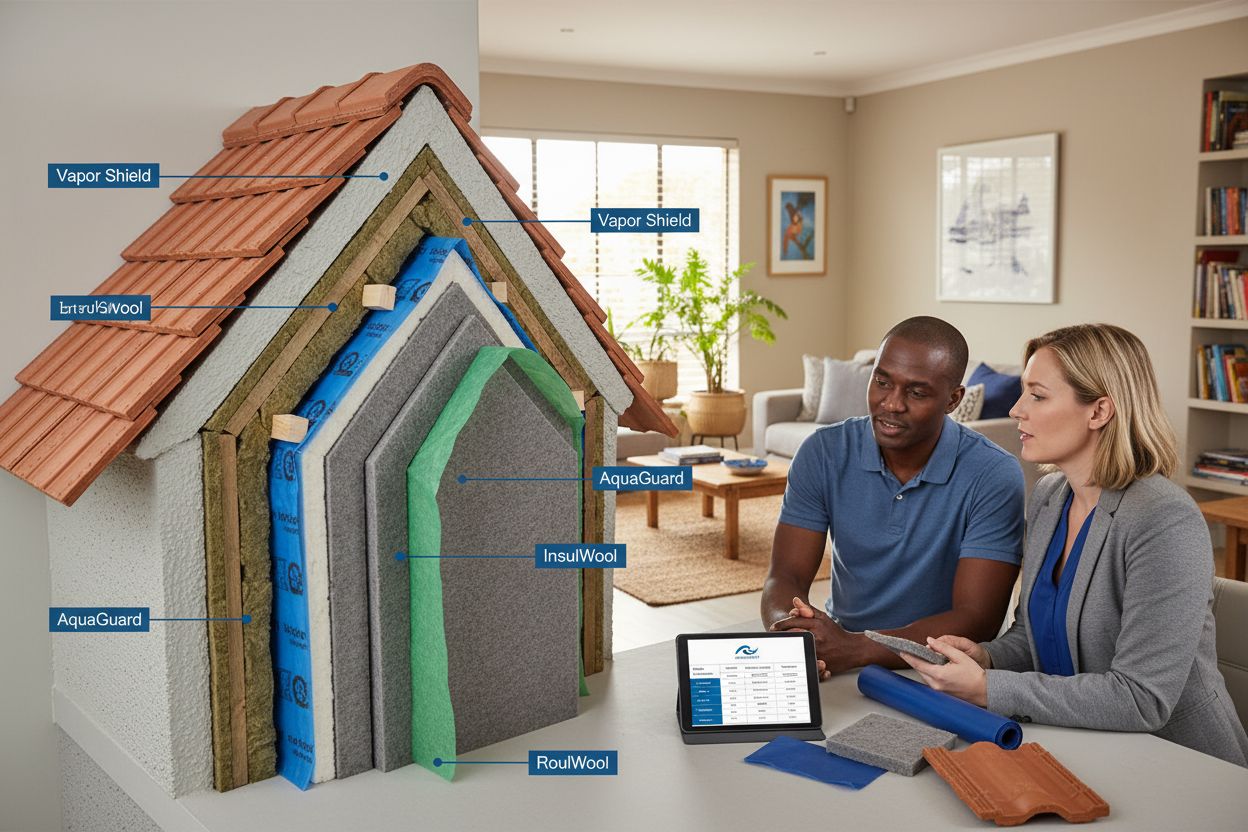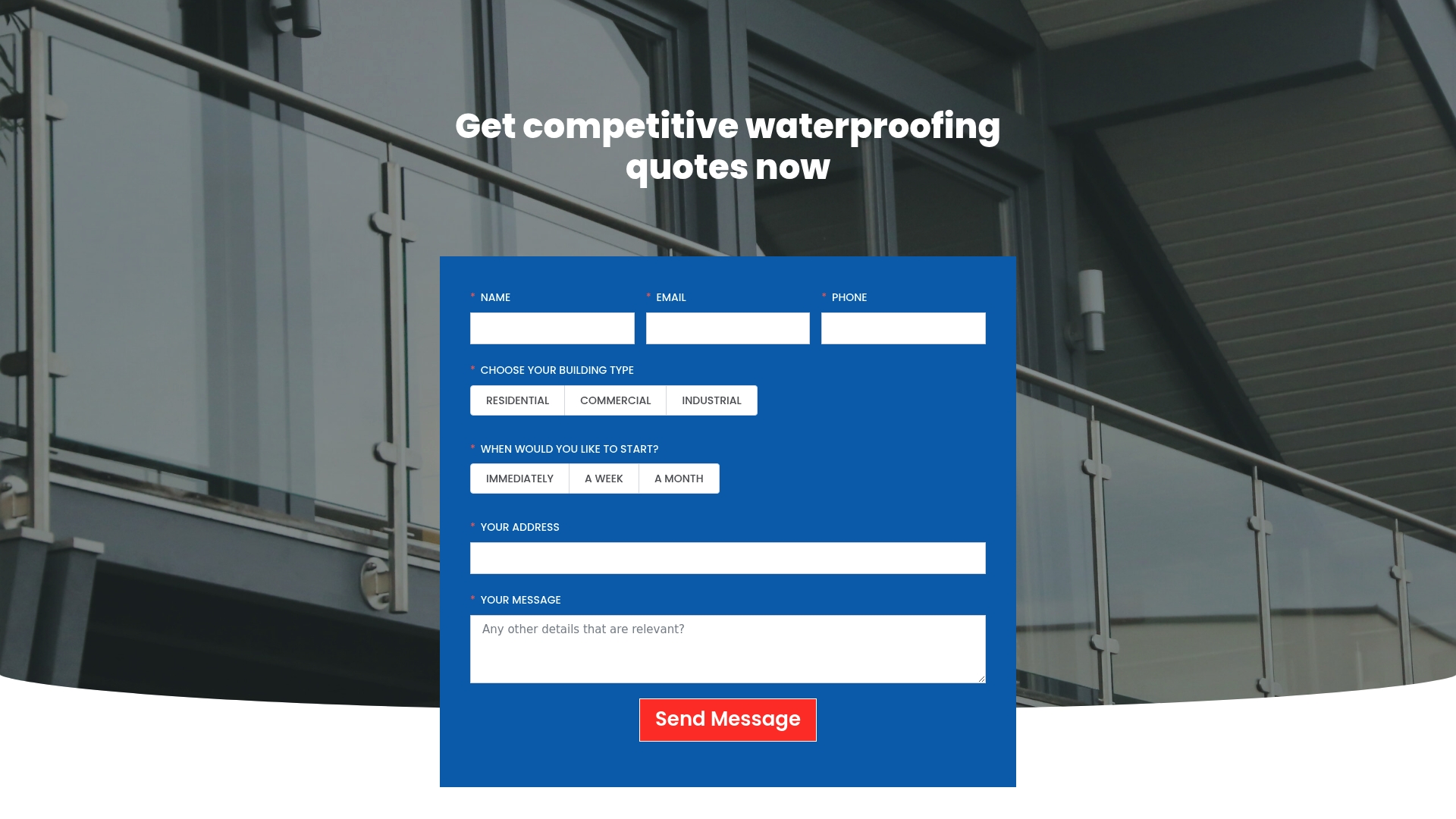Nearly 40 percent of a building’s energy use goes toward heating and cooling, according to global energy studies. Most property owners struggle with soaring energy bills and constant maintenance from water intrusion or temperature swings. Thermal waterproofing offers a proven way to minimize both moisture entry and unwanted heat transfer. Discover how specialized materials and modern techniques can deliver comfort, durability, and energy savings for homes and businesses alike.
Table of Contents
- Thermal Waterproofing Defined and Explained
- Types of Thermal Waterproofing Materials
- How Thermal Waterproofing Systems Work
- Applications in South African Properties
- Costs, Risks, and Common Mistakes
Key Takeaways
| Point | Details |
|---|---|
| Comprehensive Protection | Thermal waterproofing protects against both moisture and heat transfer, ensuring stable indoor temperatures and structural integrity. |
| Material Importance | Choosing the right thermal waterproofing materials is crucial; options like fiberglass and mineral wool provide excellent thermal resistance and moisture protection. |
| Professional Installation | Proper installation by professionals is essential to avoid common mistakes that compromise effectiveness and lead to increased energy costs. |
| Long-term Benefits | Investing in thermal waterproofing can significantly reduce utility expenses and maintenance costs, enhancing overall property value and comfort. |
Thermal Waterproofing Defined and Explained
Thermal waterproofing represents an advanced protective strategy that combines moisture resistance with thermal insulation for buildings. According to research from understanding waterproofing methods, this technique goes beyond traditional waterproofing by addressing both water infiltration and heat transfer simultaneously.
At its core, thermal waterproofing involves using specialized materials and application techniques that create a comprehensive barrier against moisture while simultaneously minimizing heat exchange between interior and exterior building environments. According to insulation experts, this approach helps maintain stable indoor temperatures, reducing energy consumption and protecting structural integrity. Key components typically include:
- Advanced insulating membranes
- Specialised sealant materials
- Multi-layer protective coatings
- Temperature-resistant waterproofing compounds
Property owners benefit significantly from thermal waterproofing through enhanced energy efficiency, reduced utility costs, and improved building durability. By preventing both water penetration and unwanted heat transfer, these systems provide comprehensive protection against environmental challenges.
The technique is particularly valuable in regions experiencing extreme temperature variations or high humidity levels, offering a proactive solution for long-term property maintenance and comfort.
Types of Thermal Waterproofing Materials
Thermal waterproofing materials play a critical role in protecting buildings from moisture and temperature fluctuations. According to types of waterproofing membranes, these specialized materials offer comprehensive protection beyond traditional insulation approaches.
Research from insulation experts highlights several key thermal waterproofing materials, each with unique characteristics. Fiberglass and mineral wool remain popular for their excellent thermal resistance and moisture-blocking properties. Other significant materials include:
Here’s a comparison of common thermal waterproofing materials and their key characteristics:
| Material | Thermal Resistance | Moisture Protection | Eco-Friendliness |
|---|---|---|---|
| Fibreglass | High | Excellent | Moderate |
| Mineral Wool | High | Excellent | Good |
| Polystyrene | Very High | Good | Low |
| Spray Foam | Very High | Excellent | Low |
| Reflective Insulation | Moderate | Good | High (if aluminium) |
| Cellulose | High | Good | Very High Recycled |
- Polystyrene: Lightweight and highly effective insulation
- Spray foam: Provides seamless coverage and exceptional sealing
- Reflective insulation: Excellent for blocking radiant heat transfer
- Cellulose: Environmentally friendly, made from recycled materials
Specialized building insulation techniques further enhance thermal protection. Different applications require specific materials – ceiling insulation like Knauf or Aerolite, cavity wall insulation, XPS floor boards, and reflective foil roof insulation provide targeted solutions for various building components. The right material selection depends on factors like climate, building structure, and specific thermal performance requirements, making professional consultation crucial for optimal results.
How Thermal Waterproofing Systems Work
Thermal waterproofing systems operate on the fundamental principle of creating a comprehensive barrier against moisture and heat transfer. Understanding waterproofing system selection reveals the intricate mechanisms that protect buildings from environmental challenges.
According to building insulation research, these systems function by strategically slowing down heat movement through critical building elements. The thermal resistance or R-value measures the system’s effectiveness in maintaining comfortable indoor temperatures and reducing energy consumption. Key operational principles include:
- Creating multi-layered barriers
- Blocking heat transfer pathways
- Preventing moisture penetration
- Regulating temperature fluctuations
The process involves sophisticated materials and techniques that work synergistically to manage thermal energy. By installing specialized membranes, insulating compounds, and reflective surfaces, thermal waterproofing systems create a dynamic shield that adapts to changing environmental conditions. This approach not only protects the building’s structural integrity but also significantly reduces heating and cooling system loads, providing long-term energy efficiency and comfort for property owners.
Applications in South African Properties
Thermal waterproofing has become increasingly critical across South African properties, addressing the unique environmental challenges posed by diverse regional climates. Understanding the importance of waterproofing in South Africa reveals the essential role these systems play in maintaining structural integrity and energy efficiency.
In regions like Johannesburg and Pretoria, where temperature fluctuations can be extreme, thermal waterproofing solutions provide comprehensive protection. Professional installations using products like Aerolite, Knauf, and Isotherm help property owners achieve significant benefits:
- Stabilising indoor temperatures
- Reducing energy consumption
- Preventing moisture-related structural damage
- Enhancing overall building comfort
The application of thermal waterproofing varies across different property types, from residential homes to commercial buildings. Coastal areas require more robust solutions to combat humidity and salt-laden winds, while inland properties focus on temperature regulation. By implementing tailored thermal waterproofing strategies, South African property owners can protect their investments, reduce long-term maintenance costs, and create more sustainable living and working environments.
Costs, Risks, and Common Mistakes
Thermal waterproofing investments require careful consideration of both upfront expenses and long-term benefits. Understanding waterproofing risks and costs highlights the critical importance of making informed decisions.
According to building insulation research, initial installation costs can vary significantly, but investing in quality materials ultimately leads to substantial energy savings. Common risks and mistakes property owners should be aware of include:
- Improper installation techniques
- Neglecting professional assessment
- Using low-quality insulation materials
- Failing to address existing moisture issues
- Overlooking specific regional climate requirements
Professional installation is paramount to prevent critical errors like creating gaps or voids that compromise thermal performance. These mistakes can dramatically reduce insulation effectiveness and lead to increased energy costs. By understanding potential pitfalls and investing in expert consultation, property owners can ensure their thermal waterproofing system delivers maximum protection, energy efficiency, and long-term value. Strategic planning and professional implementation are key to avoiding costly mistakes and maximising the return on your thermal waterproofing investment.
Protect Your Property with Expert Thermal Waterproofing Solutions
Understanding the vital need for thermal waterproofing means recognising the challenges of moisture intrusion and temperature control in your property. This comprehensive guide highlights key pain points such as preventing heat loss, avoiding costly moisture damage, and ensuring long-term structural stability. If unpredictable temperature swings and dampness worry you, the right thermal waterproofing measures can bring you peace of mind and energy savings.
Discover how specialised materials and professional installation make a difference for properties in South Africa’s varied climates. At Pro Waterproofing, we provide trusted expertise and tailored solutions that address these exact concerns. Our resources, including articles in the Uncategorized section, guide you through selecting quality products and reliable contractors to safeguard your investment.
Take control of your building’s comfort and durability today by connecting with certified professionals who understand both waterproofing and thermal insulation. Visit Pro Waterproofing now to get a quote and start protecting your property from moisture and temperature damage before it’s too late.
Frequently Asked Questions
What is thermal waterproofing?
Thermal waterproofing is a protective strategy that combines moisture resistance and thermal insulation, creating a barrier against water infiltration and heat transfer simultaneously to enhance energy efficiency and protect building structures.
What are the main components of thermal waterproofing systems?
Key components of thermal waterproofing systems typically include advanced insulating membranes, specialized sealant materials, multi-layer protective coatings, and temperature-resistant waterproofing compounds.
How does thermal waterproofing benefit property owners?
Thermal waterproofing benefits property owners by improving energy efficiency, reducing utility costs, maintaining stable indoor temperatures, and preventing moisture-related structural damage, thus enhancing long-term property durability.
What are common mistakes to avoid when installing thermal waterproofing?
Common mistakes include improper installation techniques, neglecting to address existing moisture issues, using low-quality insulation materials, and failing to consult professionals for tailored solutions specific to regional climate requirements.




